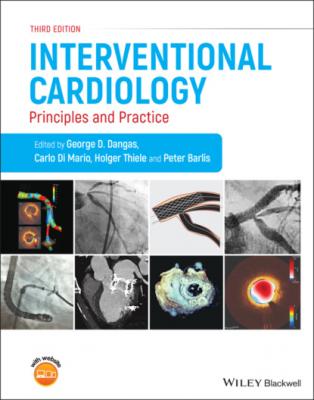Interventional Cardiology. Группа авторов
Читать онлайн.| Название | Interventional Cardiology |
|---|---|
| Автор произведения | Группа авторов |
| Жанр | Медицина |
| Серия | |
| Издательство | Медицина |
| Год выпуска | 0 |
| isbn | 9781119697381 |
CHAPTER 5
Material Selection
Alessio Mattesini, Pierluigi Demola, Sahil A. Parikh, Gioel Gabrio Secco, Michele Pighi, and Carlo Di Mario
Old photographs show Andreas Gruentzig working with his wife in a kitchen on the first coronary angioplasty balloons. They were very bulky, difficult to position as there was no guidewire lumen, and too compliant to safely expand resistant lesions in coronary arteries. Further understanding and development in manufacturing techniques and evolution of materials have reduced the profile of angioplasty balloons while increasing their robustness, deliverability, reliability, and safety profile. Similarly, workhorse guidewires have been developed with improvements in torque and force transmission while having more durable and less traumatic but shapeable tips. Specialty guidewires have been developed for the treatment of specific lesion types including chronic total occlusions. A wide range of guide catheters, guidewires, and angioplasty balloons are now available, and continue to evolve to overcome variations in anatomy, changes in vascular access, and evolution in technique. The appropriate selection and safe and optimal use of these devices can reduce procedural time and increase procedural success and safety with hopes of improving clinical outcomes.
Guide catheter selection
Functional design of modern guide catheters
Guide catheters permit safe intubation of the coronary ostia, accurate hemodynamic monitoring, injection of contrast, and passage of guidewires, balloons, and stents. The clinical, anatomic, and angiographic scenario must be considered when selecting the size, shape, and length of a guide catheter. Modern catheters have a soft tip to reduce the risk of vessel trauma during intubation or manipulation. The wall consists of an outer layer which retains a predefined curve and increases shaft stiffness to provide backup support during intervention, a middle layer of wire braid to increase kink resistance, improve torque transmission, and shaft radiopacity, and a smooth lubricated inner layer to facilitate the transit of equipment. Guide catheters have thinner walls than diagnostic catheters to increase inner lumen size and can be easily damaged by excessive rotation (Table 5.1).
Table 5.1 Guide catheter inner lumen size by manufacturer and outer lumen size.
| Guide/manufacturer | Outer lumen size (French) | ||||
|---|---|---|---|---|---|
| 5 | 6 | 7 | 8 | ||
| Launcher/Medtronic | Inner lumen (in) | 0.058 | 0.071 | 0.081 | 0.090 |
| Vista Brite Tip/Cordis | 0.056 | 0.070 | 0.078 | 0.088 | |
| Mach1/Boston Scientific | NA | 0.070 | 0.081 | 0.091 | |
| Viking/Guidant Abbott | NA | 0.068 | 0.078 | 0.091 | |
| Wiseguide/Boston Scientific | NA | 0.066 | 0.076 | 0.086 |
When difficulty is encountered in engaging the coronary ostia, one must first consider whether the guide catheter shape is appropriate. The use of a supportive 0.035inch guidewire within the catheter can facilitate manipulation. Similarly, deep inspiration by the patient can facilitate coronary intubation. In the case of excessive vascular tortuosity or calcification, the use of a peripheral sheath long enough to straighten the most tortuous arterial segments can improve guide catheter maneuverability. The optimal view for left and right coronary intubation is the left anterior oblique because in most patients it offers the least superimposition of the coronary ostia with the left and right aortic sinuses.
Size requirements
The advantages and disadvantages of smaller and larger catheter sizes are listed in Table 5.2. Routine angioplasty using 5 French (Fr) guiding catheters may be ideal when direct stenting is planned, but not all stents are deliverable through a 5 Fr guide and most bifurcation techniques are not applicable [1]. The general standard is a 6 Fr (2.00 mm external diameter) guide catheter which permits radial access, allows active engagement (“deep seat”), accommodates two modern rapid exchange balloons or a 1.50 or 1.75 mm rotational atherectomy burr, and uses less contrast than larger catheter diameters. For bifurcation techniques requiring the simultaneous insertion of two stents (Crush, V stenting), 7 Fr (2.33 mm diameter) guides are required. These are necessary for advanced techniques that require two over the wire (OTW) catheters and facilitate the insertion of rotational atherectomy burrs greater than 1.75 mm. For rotational atherectomy burrs greater than 2.0 mm in diameter and complex techniques requiring multiple wires, balloons, and/or stents, 8 Fr (2.66 mm diameter) guides are used. The use of guide catheters greater than 8 Fr is extremely rare in contemporary coronary intervention.
Table 5.2 The advantages and disadvantages of smaller versus larger catheter diameters have to be weighed when selecting catheter size.
| Smaller diameter | Larger diameter |
|---|---|
| Advantages | |
| Smaller puncture | Increased torque |
| Small vessel access | Increased support |
| Less traumatic radial access | Improved visualization |
| Allows deeper engagement without significant damping | Allows two balloon/stent strategy |
| Disadvantages | |
| Less torque | Larger puncture: increased access site trauma /recovery time |
| Reduced visualization | Pressure damping |
| Less support | Increased contrast use |
| Difficult or impossible to use two balloon/stent strategy |
Shape selection
Selection
